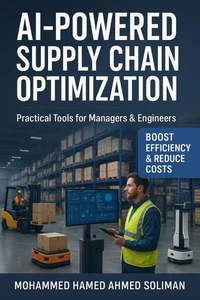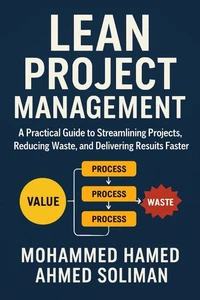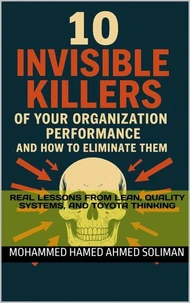Overall Equipment Effectiveness Simplified: Analyzing OEE to find the Improvement Opportunities. Lean Foundations & Advanced AI Applications Series
Par :Formats :
Disponible dans votre compte client Decitre ou Furet du Nord dès validation de votre commande. Le format ePub protégé est :
- Compatible avec une lecture sur My Vivlio (smartphone, tablette, ordinateur)
- Compatible avec une lecture sur liseuses Vivlio
- Pour les liseuses autres que Vivlio, vous devez utiliser le logiciel Adobe Digital Edition. Non compatible avec la lecture sur les liseuses Kindle, Remarkable et Sony
- Non compatible avec un achat hors France métropolitaine
 , qui est-ce ?
, qui est-ce ?Notre partenaire de plateforme de lecture numérique où vous retrouverez l'ensemble de vos ebooks gratuitement
Pour en savoir plus sur nos ebooks, consultez notre aide en ligne ici
- FormatePub
- ISBN8215330746
- EAN9798215330746
- Date de parution25/09/2020
- Protection num.Adobe DRM
- Infos supplémentairesepub
- ÉditeurWMG Publishing
Résumé
Boost Manufacturing Performance by Mastering OEEIs your equipment running at peak efficiency-or costing you money in hidden losses?In Overall Equipment Effectiveness Simplified, you'll learn how to uncover and eliminate the hidden inefficiencies in your production line using one of the most powerful metrics in manufacturing: OEE. This hands-on guide will help you: Understand the 3 core pillars: Availability, Performance, and Quality Diagnose problems using Six Big Losses Link OEE to Total Productive Maintenance (TPM) and Lean initiatives Discover real-world improvement opportunities-fast Whether you're a production manager, process engineer, or continuous improvement leader, this book gives you the tools to stop guesswork and start data-driven improvement.
More about this Book:Overall Equipment Effectiveness (OEE): A measurement of total productive maintenance (TPM) that quantifies how efficiently equipment is used. OEE is derived from three factors: Availability rate: calculates the percentage of scheduled time lost due to equipment breakdowns and changeovers Performance rate: measures operating speed losses-running slower than the design speed and brief stops Quality rate: calculates the percentage of parts lost to scrap and rework OEE is calculated by multiplying these three components, and each one presents numerous improvement opportunities.
The six primary losses-failures, modifications, small stoppages, lower operating speeds, and scrap-are often the focus of OEE, but some businesses also include other significant measures they deem important.
More about this Book:Overall Equipment Effectiveness (OEE): A measurement of total productive maintenance (TPM) that quantifies how efficiently equipment is used. OEE is derived from three factors: Availability rate: calculates the percentage of scheduled time lost due to equipment breakdowns and changeovers Performance rate: measures operating speed losses-running slower than the design speed and brief stops Quality rate: calculates the percentage of parts lost to scrap and rework OEE is calculated by multiplying these three components, and each one presents numerous improvement opportunities.
The six primary losses-failures, modifications, small stoppages, lower operating speeds, and scrap-are often the focus of OEE, but some businesses also include other significant measures they deem important.
Boost Manufacturing Performance by Mastering OEEIs your equipment running at peak efficiency-or costing you money in hidden losses?In Overall Equipment Effectiveness Simplified, you'll learn how to uncover and eliminate the hidden inefficiencies in your production line using one of the most powerful metrics in manufacturing: OEE. This hands-on guide will help you: Understand the 3 core pillars: Availability, Performance, and Quality Diagnose problems using Six Big Losses Link OEE to Total Productive Maintenance (TPM) and Lean initiatives Discover real-world improvement opportunities-fast Whether you're a production manager, process engineer, or continuous improvement leader, this book gives you the tools to stop guesswork and start data-driven improvement.
More about this Book:Overall Equipment Effectiveness (OEE): A measurement of total productive maintenance (TPM) that quantifies how efficiently equipment is used. OEE is derived from three factors: Availability rate: calculates the percentage of scheduled time lost due to equipment breakdowns and changeovers Performance rate: measures operating speed losses-running slower than the design speed and brief stops Quality rate: calculates the percentage of parts lost to scrap and rework OEE is calculated by multiplying these three components, and each one presents numerous improvement opportunities.
The six primary losses-failures, modifications, small stoppages, lower operating speeds, and scrap-are often the focus of OEE, but some businesses also include other significant measures they deem important.
More about this Book:Overall Equipment Effectiveness (OEE): A measurement of total productive maintenance (TPM) that quantifies how efficiently equipment is used. OEE is derived from three factors: Availability rate: calculates the percentage of scheduled time lost due to equipment breakdowns and changeovers Performance rate: measures operating speed losses-running slower than the design speed and brief stops Quality rate: calculates the percentage of parts lost to scrap and rework OEE is calculated by multiplying these three components, and each one presents numerous improvement opportunities.
The six primary losses-failures, modifications, small stoppages, lower operating speeds, and scrap-are often the focus of OEE, but some businesses also include other significant measures they deem important.























